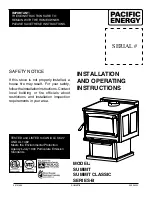
A lower value does not permit proper combustion with the consequent formation of carbon
deposits and excessive production of smoke, which, being unable to flow to the exterior
will escape through the grills or doors.
If the draught value is too high, combustion will be too fast, with the consequent dispersion
of the heat through the flue. If the draught is greater than 15Pa, the elements for draught
reduction should be installed.
The signs of a bad draught are:
dirty glass, boiling handle
smoke coming out into the room
4.1 General characteristics
To facilitate the draught in the flue, the chimney must be rising at least one metre
above the ridge of the roof.
The dimensions of the chimney may vary on the basis of the model of flue. However, to
guarantee good disposal of the fumes, the section of the air passage at its exit must
always be twice the section of the flue itself, and furthermore the cap of the chimney must
never obstruct the draught.
The chimney guarantees the conveyance of the fumes outwards even when there are high
horizontal winds and stops them from being blown back down the chimney.
Bad maintenance of chimney is the cause of flue obstruction, due to the breaking and
detachment of plaster, refractory bricks etc.
Chimney must have sufficient heat insulation, otherwise it can lead to condensation.
The internal parts of the whole flue should have a smooth surface, and the material used
should be refractory and resistant to their degree of acidity, and should be impermeable to
gases.
4.2 Chimney recommendations
The internal part of the whole flue should have a smooth surface, and the material used
should be resistant to heat and impermeable to gases.
.
Height of the flue
Round section
Square section
5 m
10 m
15 m
cm. 20/22
cm. 18/20
cm. 15/16
cm. 20 x 20
cm. 18 x 18
cm. 16 x 16
4.3 Connection of the stove to the flue
The metal tube connecting the stove to the flue must never have a smaller diameter






































